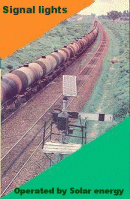![]()
![]()
By
Chief Signal Engineer/Eastern Railway
(The webmaster is grateful to Sri S.Ganguly, CSE/ER (2001) for permitting this article to be published for information of rail enthusiasts)
The history of signalling dates back to as early as 1814, the year of
the first practical use of George Stephenson’s Steam
Locomotive. The first rail cars were pulled by horses and mules and were
used in mines and quarries. Records as early as 1806 show that hand
and arm signals were used to direct the movement of these early trains.
Hand signals, flags in day
 and lanterns at night were used to signal ‘B’ & ‘O’ trains in 1829.
In some cases a mounted flagman preceded the train. This system continued in New
York city in West St. as late as 1920’s.
and lanterns at night were used to signal ‘B’ & ‘O’ trains in 1829.
In some cases a mounted flagman preceded the train. This system continued in New
York city in West St. as late as 1920’s.
Signalling using fixed track side signals began first in U.S. on New
Castle and French Town Railroad in 1832. This 17 mile railroad used fixed
signals, flags at first and later ball signals to pass information from one
terminal to another.
BLOCK SIGNALLING
The early trains operation was more or less by schedules and hence train separation was by time separation. As traffic increased tracks were divided into blocks and trains separation was by space inte3rval. This is how block signalling began., Various electrical and mechanical systems were tried, the objective being letting one train pass into a block and inhibiting the block entering signal from clearing to allow another train into the block until the first train was reported to have left the block. Subsequently, systems having permissive feature also came into being which allowed trains to follow each other into the same block.
From 1851 the telegraph was used to determine the location and progress of trains along the line and to transmit train orders to expedite traffic.
All the above systems required substantial manpower and had no protection against a part of a train being accidentally left in a block section between block stations.
On 20.10.1872, Dr. William Robinson invented the closed track circuit which gave great fillip in Railway signalling. First installed in Kinzua, PA the closed track circuit quickly proved its worth and other installations involving closed track circuit followed rapidly. All modern track circuits are based on Dr. Robinson’s original concept, even through their capabilities have been greatly enhanced by modern track relays, coding and more recently electronic techniques such as audio and high frequency joint less track circuits.
The next advance in block signalling came in 1911 when Sedgwick N. Wight a GRS engineer invested APB i.e. absolute permissive block signalling. This allows train to operate in either direction of single track with full signal direction for both following and opposing movement.
![]()
INTERLOCKING
The first installation resembling interlocking was installed at Bricklayer’s Arms Junction in England in 1843 wherein switches and signals were operated by a switchman with hand levers and foot stirrups respectively. However, there was no interlocking between switches and signals. Switches were sometimes thrown under trains and signals cleared over open switches but the advantages of centralized control were achieved.
In 1856, the first mechanical interlocking incorporating essential interlocking requirements was developed by John Saxby in England. In United States the first interlocking was put in service in 1870 at Trenton, New Jersy. Gradually, mechanical frames were replaced by various types power interlocking, such as hydro pneumatic and electro pneumatic system. In 1901 the Taylor Signal company commissioned the first all-electric, dynamic indication interlocking at Eau Claire, Wis., on the Chicago, St. Paul, Minneapolis and Omaha railway. This system was an immediate success and thousands of levers were installed some of which are still in service.
The next development, Relay Interlocking, which requires no mechanical locking between the levers, developed with CTC i.e. Centralised Traffic Control.
CENTRALISED
TRAFFIC CONTROL

On July 25th 1927 the first CTC system, invested by Sedgwick N. Wight (the inventor of APB), commissioned between Stanley and Berwick, Ohio on the Ohio Division of New York Central Railroad, This tremendously improved facility and economy in train operation.
ALL RELAY INTERLOCKING
In 1929, GRS commissioned first remotely controlled unit wire all relay interlocking system on the Chicago, Burlington and Quincy at Lincoln, Nebraska.
The first installation of all relay Interlocking with push button, automatic selection of routes and positioning of switches and signals, the GRS type NX, was made at Brunswick, England on the Cheshire Lines, in February 1937. The first NX route-type interlocking in the United States was installed at Girard Jct., Ohio, on the New York Central in 1937.

THANKS FOR THE VISIT
Send your comments mreenaldas@yahoo.co.in
Divisions : Sealdah Howrah Asansol Maldah
Workshops : Jamalpur Liluah Kanchrapara
HOME Bouquets and Brickbats